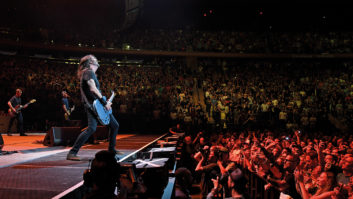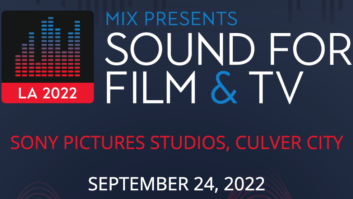SANTA ANA, CA—After more than three decades in the industry, Ron Leeper has come full circle, once again mastering to vinyl, and in the facility that he first established in 1978. Sound Affair Mastering opened for business at its new location at the beginning of the year, setting up shop in a space at the front of the new Blue Velvet Studio complex in Santa Ana, CA, 30 miles south of Los Angeles.
Mastering Engineer Ron Leeper in between Sound Affair’s Ampex ATR-102 reel deck and Scully lathe. Leeper opened Sound Affair in 1978 as a multitrack recording studio after working as a mastering engineer at Hank Waring’s DCT Recorders and Quad Teck in Hollywood, where he cut disks on Neumann and Scully lathes. He previously studied audio recording and mastering at the Institute of Audio Research in New York City.

“I’m very thankful that I was trained and mentored by Hank; he used to be a cutter at Capitol in the ’60s, mastering all the hits,” he says.
Sound Affair went through some changes as the years progressed, according to Leeper. “In keeping with the changing tides in the industry, I opened it as a small 16-track room in the mid-’70s, then in 1980-81, I moved everything out and turned it into 24-track room, because that was getting more and more popular. I ran that for quite a while, doing all kinds of projects.
“In the early ’90s, I could see the dawn of home recording coming with ADAT. The calls were getting fewer and fewer, so I had to do something. You go full circle sometimes in this business; I got back into mastering, which is where I started years ago when I worked in Hollywood, with CD audio, and now vinyl.”
In its annual report on the record business, published in March, the Recording Industry Association of America (RIAA) noted that physical format sales declined from 2013 to 2014. But drill down deeper and you will find that vinyl singles essentially doubled in revenue share during the period, from $3 million to $5.9 million. LPs and EPs increased by 50 percent in those same 12 months, and now account for $315 million in sales.
That growth, which has been ongoing for some years, did not go unnoticed by Leeper. “I would master for CD, then clients would have me make a secondary master for vinyl. That kept growing and growing, and then I had folks say they just wanted it mastered for vinyl. I was thinking, what’s going on here? I’ve got to get back into this again.”
So Leeper went in search of a lathe, finding one for sale by a private seller near Boston, MA. “It’s a Scully 600 series, made sometime between 1962 and 1964. It’s called the automated lathe: It does automatic banding, automatic head drop and automatic head lift. It’s all original—all 1,200 pounds of it—although I did some modifications.”
Over the past five years, he has also amassed a HAECO (Holzer Audio Engineering Company) solid-state disk-cutting system. “It was made by Howard Holzer; Howard was the main design engineer at A&M for years and designed all their consoles, microphone preamps, amplifiers and disk-cutting equipment,” he says.
One reason for vinyl’s resurgence is that smaller artists are able to make money by selling records at the merchandise table during gigs. “You have a physical product, you sell it and you make money,” says Leeper, who reports, “My primary work is with quantities from 200 to 500. Occasionally there will be a run of 1,000.”
If there is bottleneck in the vinyl industry, it’s at the pressing stage. “There are only so many pressers and only so many machines,” he says. “But people are managing to unearth pressing machines and get them back into working condition.”
Leeper, who has been mastering almost exclusively for the past 20 years or so, temporarily moved out of the building after Blue Velvet’s owners acquired it. They custom-built a new mastering room for him, designed by Ken Rains of Rains Audio Engineering, turning the facility into a one-stop shop that also offers direct-to-disk services.
“It took a good year to get this room done; a lot of work went into it.” In the meantime, he says, “I set up a rig in my house and was still able to turn projects around in a reasonable amount of time.”
The console features Leeper’s rare Focusrite Blue Range, a complete analog mastering system introduced in the mid-1990s. “You have a controller, EQ, compressor, and A/D and D/A,” he elaborates. “That’s the heart of the mastering system here.” Other favored pieces in the room included an SPL Vitalizer, an ADR Selective Band Processor and a Waves L2, plus a Fairchild 602 stereo high frequency limiter that came with the disk-cutting package.
The monitors are soffit-mounted Tannoy DMT 15 IIs: “I’ve been using them forever. It’s a bi-amped system; I’ve had the vintage UREI amps since the early ’80s. I’ve mixed millions of records on them. When a project leaves here, I know what it sounds like, and that’s important.”
Sound Affair Mastering
www.soundaffairmastering.com







